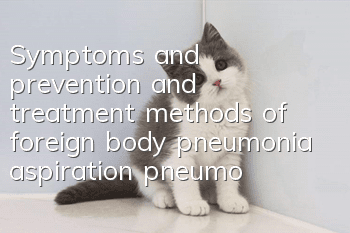Symptoms and prevention and treatment methods of foreign body pneumonia (aspiration pneumonia) in cats

Cat foreign body pneumonia, also known as aspiration pneumonia, refers to inflammation of the bronchi and lungs caused by inhalation of foreign bodies into the lungs. Necrosis and decomposition of lung tissue due to putrefactive bacterial infection is called pulmonary gangrene. Clinically, it is characterized by extreme difficulty breathing and purulent or putrefactive nasal fluid flowing from both nostrils.
Causes of foreign body pneumonia in cats
Phagocytosis disorder and forced infusion of drugs are the most common causes of foreign body pneumonia. When sick dogs develop pharyngitis, pharyngeal paralysis, esophageal obstruction, and encephalopathy with impaired consciousness, aspiration or accidental swallowing may occur due to difficulty in swallowing, leading to foreign body pneumonia.
Foreign bodies entering the lungs initially cause catarrhal inflammation of the bronchi and pulmonary lobules, and then the pathological process intensifies, eventually leading to pulmonary gangrene.
Symptoms of foreign body pneumonia in cats
In the early stage, the sick dog showed symptoms of bronchopneumonia, rapid and difficult breathing, abdominal breathing, and wet cough. The body temperature rises, the pulse is fast and weak, and sometimes trembling. In the later stages, the sick dog's breath has a putrid stench, and foul-smelling nasal fluid flows out of both nostrils. The nasal fluid is collected in a glass and can be divided into three layers. The upper layer is mucus with foam; the middle layer is serous and contains floc; the lower layer is pus mixed with a lot of lung tissue. When observed under a microscope, lung tissue fragments, fat droplets, fat crystals, brown to black pigment particles, red blood cells, white blood cells and a large number of microorganisms can be seen. Boil the nasal fluid in 10% potassium hydroxide solution, and centrifuge the precipitate. When observed under a microscope, elastic fibers decomposed from the lung tissue can be seen.
Pulmonary examination showed obvious chest pain and rales. In the early stage, due to the extensive lung tissue being in the inflammatory infiltration stage, there is dullness to percussion. Later, lung cavities appear and focal tympani may be found. If the cavity is surrounded by dense tissue, there will be a metallic sound to percussion; if the cavity is connected to the bronchi, there will be a burping sound.
Key points for diagnosis and prevention and treatment measures of foreign body pneumonia in cats
1. Key points of diagnosis
Diagnosis can be made based on medical history and clinical features. If clear lung cavities and shadows of necrosis are seen in X-ray examination, the diagnosis is easier to make. However, it must be differentiated from septic bronchitis. Dogs with septic bronchitis lack high fever and have no elastic fibers in their nasal fluid.
2. Prevention and Control Measures
The principle of treatment is to quickly expel foreign matter, prevent the decay and decomposition of lung tissue, relieve dyspnea and provide symptomatic treatment. Pilocarpine 0.2-1 ml can enhance tracheal secretion and promote the rapid discharge of foreign bodies. When a sick dog has high difficulty breathing, it should be given oxygen as soon as possible. answerAntimicrobial therapy was performed with intravenous and intratracheal infusion of spectrum antibiotics.
- A cat will die if it urinates for a few days
- Should you deworm yourself or go to a pet store?
- Are cat teasers harmful to cats?
- What should I do if my cat suffers from chronic gingivitis?
- Cat's nails are cracked with a thin layer
- Cats go crazy after eating mutton
- What does cat moss on a cat’s chin look like?
- Can cats reproduce after abdominal transmission is cured?
- What exactly is the sterilization shot for female cats?
- Can I still eat unopened cat food if it has expired?



